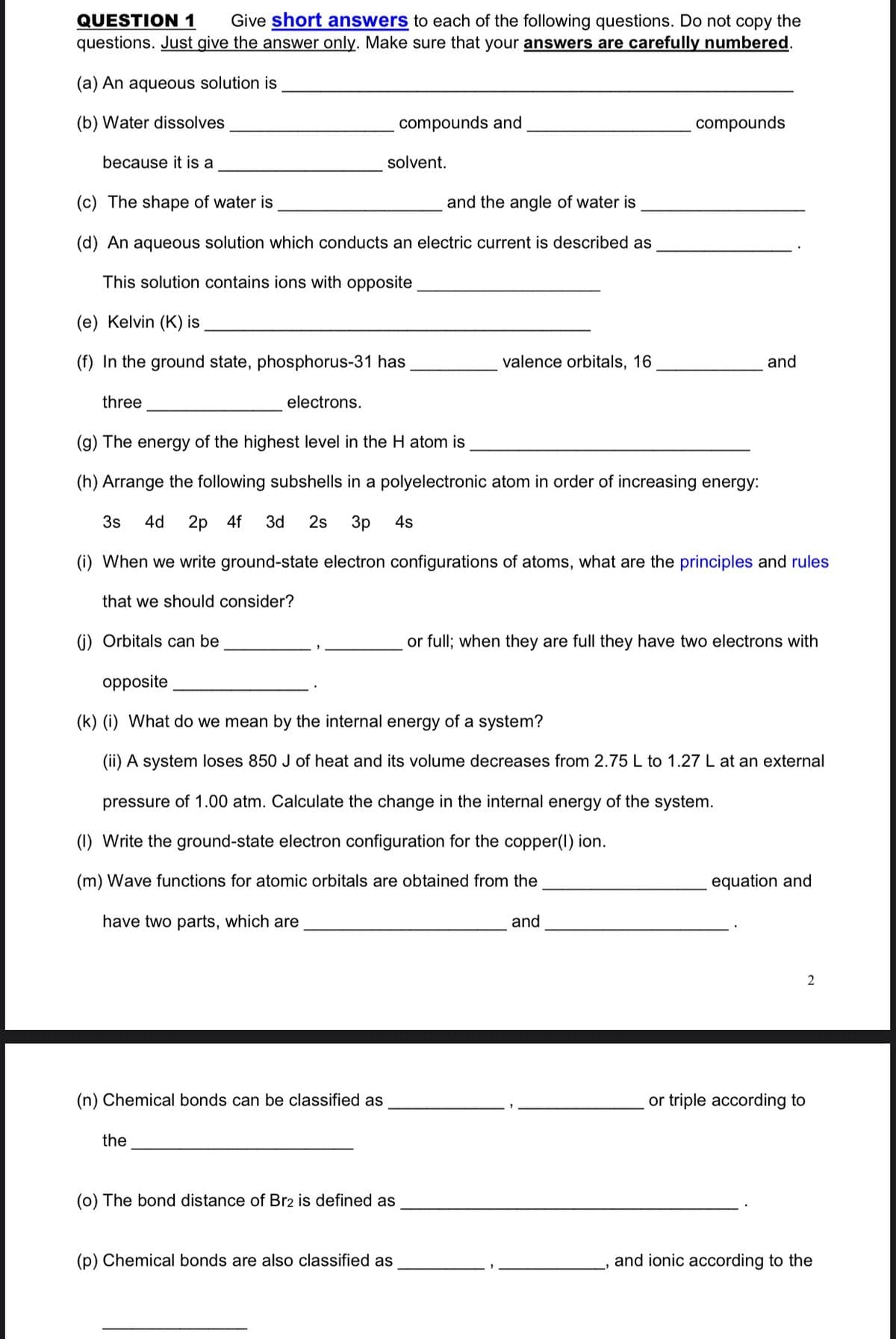Give short answers to each of the following questions. Do not copy the QUESTION 1 questions. Just give the answer only. Make sure that your answers are carefully numbered. (a) An aqueous solution is (b) Water dissolves compounds and compounds because it is a solvent. (c) The shape of water is and the angle of water is
Give short answers to each of the following questions. Do not copy the QUESTION 1 questions. Just give the answer only. Make sure that your answers are carefully numbered. (a) An aqueous solution is (b) Water dissolves compounds and compounds because it is a solvent. (c) The shape of water is and the angle of water is
Chemistry: Principles and Reactions
8th Edition
ISBN:9781305079373
Author:William L. Masterton, Cecile N. Hurley
Publisher:William L. Masterton, Cecile N. Hurley
Chapter10: Solutions
Section: Chapter Questions
Problem 73QAP: Consider three test tubes. Tube A has pure water. Tube B has an aqueous 1.0 m solution of ethanol,...
Related questions
Question

Transcribed Image Text:QUESTION 1
questions. Just give the answer only. Make sure that your answers are carefully numbered.
Give short answers to each of the following questions. Do not copy the
(a) An aqueous solution is
(b) Water dissolves
compounds and
compounds
because it is a
solvent.
(c) The shape of water is
and the angle of water is
(d) An aqueous solution which conducts an electric current is described as
This solution contains ions with opposite
(e) Kelvin (K) is
(f) In the ground state, phosphorus-31 has
valence orbitals, 16
and
three
electrons.
(g) The energy of the highest level in the H atom is
(h) Arrange the following subshells in a polyelectronic atom in order of increasing energy:
3s
4d
2р 4f
3d
2s
3p
4s
(i) When we write ground-state electron configurations of atoms, what are the principles and rules
that we should consider?
(i) Orbitals can be
or full; when they are full they have two electrons with
opposite
(k) (i) What do we mean by the internal energy of a system?
(ii) A system loses 850 J of heat and its volume decreases from 2.75 L to 1.27 L at an external
pressure of 1.00 atm. Calculate the change in the internal energy of the system.
(1) Write the ground-state electron configuration for the copper(1) ion.
(m) Wave functions for atomic orbitals are obtained from the
equation and
have two parts, which are
and
2
(n) Chemical bonds can be classified as
or triple according to
the
(0) The bond distance of Br2 is defined as
(p) Chemical bonds are also classified as
and ionic according to the
Expert Solution
This question has been solved!
Explore an expertly crafted, step-by-step solution for a thorough understanding of key concepts.
This is a popular solution!
Trending now
This is a popular solution!
Step by step
Solved in 2 steps with 1 images

Knowledge Booster
Learn more about
Need a deep-dive on the concept behind this application? Look no further. Learn more about this topic, chemistry and related others by exploring similar questions and additional content below.Recommended textbooks for you

Chemistry: Principles and Reactions
Chemistry
ISBN:
9781305079373
Author:
William L. Masterton, Cecile N. Hurley
Publisher:
Cengage Learning

Chemistry: An Atoms First Approach
Chemistry
ISBN:
9781305079243
Author:
Steven S. Zumdahl, Susan A. Zumdahl
Publisher:
Cengage Learning


Chemistry: Principles and Reactions
Chemistry
ISBN:
9781305079373
Author:
William L. Masterton, Cecile N. Hurley
Publisher:
Cengage Learning

Chemistry: An Atoms First Approach
Chemistry
ISBN:
9781305079243
Author:
Steven S. Zumdahl, Susan A. Zumdahl
Publisher:
Cengage Learning


Chemistry
Chemistry
ISBN:
9781305957404
Author:
Steven S. Zumdahl, Susan A. Zumdahl, Donald J. DeCoste
Publisher:
Cengage Learning

Chemistry for Today: General, Organic, and Bioche…
Chemistry
ISBN:
9781305960060
Author:
Spencer L. Seager, Michael R. Slabaugh, Maren S. Hansen
Publisher:
Cengage Learning

EBK A SMALL SCALE APPROACH TO ORGANIC L
Chemistry
ISBN:
9781305446021
Author:
Lampman
Publisher:
CENGAGE LEARNING - CONSIGNMENT